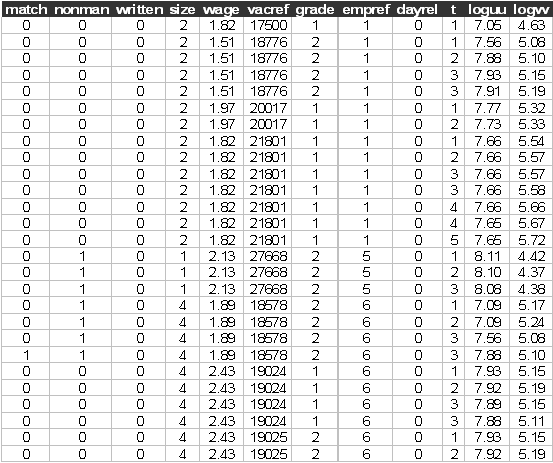Exercise 3LC5. Event history, cloglog link model: time
to fill vacancies of firms (1736 vacancies in 515 firms)
This is a study of the length of time (level 1, observed at the weekly
level) needed to fill vacancies (level 2) by employers (level 3) in the vacancy
data sub set vwks4emp_vars_30k.dat. We
estimate a stock model of the duration of the vacancy; in addition to the
firm’s characteristics and those of the vacancy, we use covariates which
represent the stock of the labour market at the current duration, i.e. the
total number of job-seekers (logged) and the total number of vacancies (logged)
in the local labour market.
Reference
Andrews, M., Bradley, S., Stott, D., Upward, R., (2007), Testing theories of labour market matching, http://ideas.repec.org/p/ecj/ac2003/209.html
Data
description
Number of observations = 28791 (weeks)
Number of level-2 cases (‘vacref’ = identifier for vacancy) = 1736
Number of level-3 cases (‘empref’ = identifier for firm) = 515
The variables are:
match = 1 if vacancy filled, 0 otherwise in a particular week
nonman = 1 if a non-manual vacancy, 0 otherwise
written = 1 if vacancy required a written method of application, 0 otherwise
size = firm size of the vacancy
wage = log wage of the vacancy
vacref = vacancy reference (a number)
grade = grade required by the vacancy
empref = employer reference (a number)
dayrel = 1 if day release available to the post, 0 otherwise
t = vacancy duration (see below)
loguu = log of stock of job-seekers in the local labour market
logvv = log of stock of vacancies in the local labour market
The covariate (t) for the baseline hazard is defined as follows:
t=1, week 1
t=2, week 2
t=3, weeks 3-4
t=4, weeks 5-6
t=5, weeks 7-8
t=6, weeks 9-13
t=7, weeks 14-26
t=8, weeks 27-39
t=9, weeks 40-52
t=10, weeks 53+
The first few lines and columns of vwks4emp_vars_30k.dat look like:

Suggested
exercise:
1. Estimate a cloglog link model (without random effects) for the binary response match, treat t as a factor variable and include the covariates (loguu, logvv, nonman, written, size, wage, grade, dayrel).
2. Allow for a level-2 vacancy random effect, use mass 32. Is this random effect significant?
3. Re-estimate the model with the level-2 random effect (subject) and firm as the level 3 random effect. Use mass 32 for both levels. Are both these random effects significant?
4. How did your results on some important variables e.g. t change, when you allowed for both vacancy-level (level 2) and then firm-level (level 3) random effects?